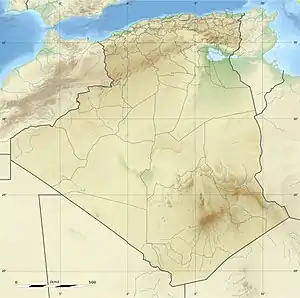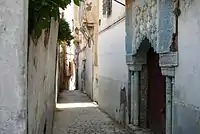Casbah of Algiers
Thé Casbah (Arabic: قصبة, qaṣba, meaning citadel (fortress) is specifically the citadel of Algiers in Algeria and the traditional quarter clustered around it. In 1992, the United Nations Educational, Scientific and Cultural Organization (UNESCO) proclaimed Kasbah of Algiers a World Cultural Heritage site, as "There are the remains of the citadel, old mosques and Ottoman-style palaces as well as the remains of a traditional urban structure associated with a deep-rooted sense of community."[1]
| UNESCO World Heritage Site | |
|---|---|
 | |
| Location | Algiers, Algeria |
| Criteria | Cultural: ii, v |
| Reference | 565 |
| Inscription | 1992 (16th session) |
| Area | 54.7 ha |
| Coordinates | 36°47′0″N 3°3′37″E |
 Location of Casbah of Algiers in Algeria | |
Etymology
More generally, a kasbah is the walled citadel of many North African cities and towns.[2] The name made its way into English from French in the late 19th century (the Oxford English Dictionary states 1895), and often is spelled "kasbah," but also "casbah."[3]
History
The Casbah of Algiers is founded on the ruins of old Icosium in the 10th century. It was a city built on a hill, goes down towards the sea, divided in two: the High city and the Low city. One finds there masonries and mosques of the 17th century; Ketchaoua Mosque (built in 1794 by the Dey Baba Hassan) flanked of two minarets, Djama’a al-Djedid (1660, at the time of the ottomans) with its large finished ovoid cupola points some and its four coupolettes, Djamaâ el Kebir (oldest of the mosques, it was built by Almoravid ruler Yusuf ibn Tashfin), Ali Bitchin Mosque (Raïs, 1623). The casbah also contained several palaces, including Dar Aziza, Dar Mustapha Pacha, Palace of the Dey, and Dar Hassan Pacha which was built in 1791 to house the Pasha, who lived there for eight years.[4]
In 1839, shortly after the French conquest, the French governor moved into Dar Hassan Pacha. In 1860, Napoleon III and Eugénie de Montijo visited.[4] Before French rule, the casbah contained around 13 Jama Masjids, 109 mosques, 32 mausoleums and 12 Zawiyas, total of 166 religious-related buildings. However, the majority of these religious buildings were destroyed during the occupation. In 1862, there were only nine Jama Masjids, 19 mosques, 15 mausoleums and five Zawiyas left. Many mosques such as Ketchauoua Mosque and Berrani Mosque were converted into building with non-Islamic purposes, such as military barracks and churches.[5]
The Casbah played a central role during the Algerian War of Independence (1954–1962). During the early years of the war, the Casbah was the epicenter of the insurgency planning of the National Liberation Front (FLN), from which it planned and executed attacks against French citizens and law enforcement agents in Algeria at the time. In order to counter their efforts, the French authorities launched operations in the Casbah during the Battle of Algiers.
Current condition
A Reuters reported in August 2008 the Casbah was in a state of neglect and certain areas were at risk of collapse.[6]
Algerian authorities list age, neglect and overpopulation as the principal contributors to the degeneration. Overpopulation makes the problem especially difficult to solve because of the effort it would take to relocate the residents. Estimates range from 40,000 to 70,000 people, although it is difficult to be certain due to the number of squatters in vacant buildings.[7] One reason that the government wants to improve the condition of the Casbah is that it is a potential hideout for criminals and terrorists. In the late 1950s and during the civil insurrection and struggle against French colonial rule it was the hideout for the National Liberation Army (Algeria).
Preservationist Belkacem Babaci described the situation as difficult, but not insurmountable, saying: “I still believe it’s possible to save it, but you need to empty it and you need to find qualified people who will respect the style, the materials. It’s a huge challenge.”[8]
 Casbah Palace (Hammam)
Casbah Palace (Hammam) Streetscape
Streetscape A Casbah house interior architecture
A Casbah house interior architecture Fishing port down of the Casbah
Fishing port down of the Casbah
Notable people
- Abd al-Rahman al-Tha'alibi
- Abdelhalim Bensmaia
- Mohamed Charef (1908-2011)
- Brahim Boushaki (1912-1997)
- Djamila Bouhired
- Djamila Boupacha
- Mustapha Toumi
References
- UNESCO, Decision Text, World Heritage Centre, retrieved 21 July 2017
- Arabic Name Translator. "The Casbah (Arabic: قصبة, qaṣba, meaning citadel (fortress)) is specifically the citadel of Algiers in Algeria and the traditional quarter clustered around it. More generally, a kasbah is the walled citadel of many North African cities and towns."
- Tanya Reinhart Israel/Palestine: How to End the War of 1948 2011- Page 151 "The Jenin refugee camp and the Casbah in Nablus were considered by the Israeli army to be the toughest areas to conquer. Preparations to seize these areas began long in advance. In January 2002, Amir Oren reported in Ha'aretz that the ..."
- "Interior of Governors Palace, Algiers, Algeria". World Digital Library. 1899. Retrieved 2013-09-25.
- دويرات القصبة تحتضّر ومساجدها العتيقة مهدّدة بالاندثار.. فهل من مغيث؟. El Mihwar. Retrieved January 9, 2018.
- William Maclean (2008-09-01). "REUTERS, William Maclean, Aug 31, 2008". Reuters.com. Retrieved 2010-06-19.
- "Algeria Channel". Algeria.com. Retrieved 2010-06-19.
- "Wall Street Journal Blogs, The Informed Reader, July 5, 2007, 9:39 AM ET". Blogs.wsj.com. 2007-07-05. Retrieved 2010-06-19.
External links
| Look up casbah of algiers in Wiktionary, the free dictionary. |
| Wikimedia Commons has media related to Casbah of Algiers. |
- Smith, Craig S. (2006-07-23). "The Crumbling of the Casbah". The New York Times. Retrieved 2008-02-08.
- Hammer, Joshua (July 2007). "Save the Casbah". Smithsonian.